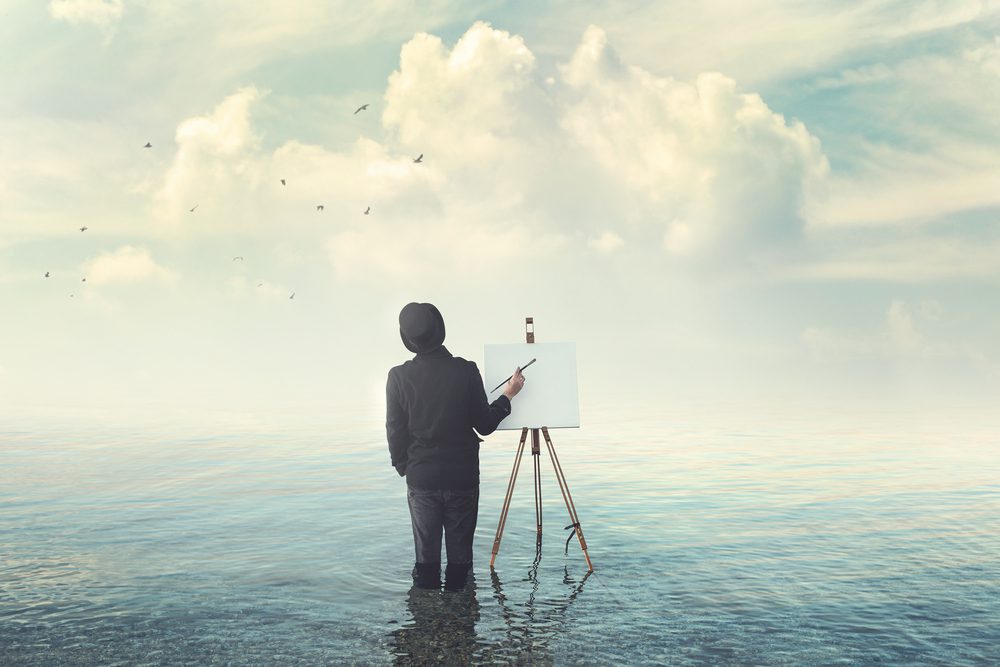Is there a place for imagination in meditation?
Absolutely! The reasons for meditating are influenced by the needs and longings of the individual. But a common motivation for wanting to learn meditation is wanting to discover a different way of responding to the frequently chaotic, and often overwhelming circumstances of daily life. While meditation can help, you cannot discover an alternative way of living without first imagining that it’s a possibility.

A Case for Imagination.
There are many examples of how imagination has been the seed for growing possibilities into something real. In the same way, imagination and meditation when used together, powerfully interact to bring about the possibility for change.
For example, during the early days of Covid, scientists imagined the possibility of developing a vaccine. It took months of commitment and work, but they brought what they imagined to fruition.
Another example is seen in the young life of Greta Thunberg. Of course, I don’t know what was in her mind, but I can’t help but wonder if she may have imagined that sailing thousands of miles might make a point and call attention to the ecological crisis of our Earth. Her actions turned what started as an imagining and grew it into something very real.
However, examples of imagination as seeds of possibilities do not have to be heroic: For instance, would teachers be able to teach if they didn’t imagine the possibility that their students could learn? Can a house be built, without the imagination of an architect to design it? There are countless ideas and possibilities imagined and actualized every day. Even by the workers who lay brick upon brick with skill because they imagined they could go to work and earn a living by being a mason.
I’m emphasizing the importance of imagination, not just to show the external results, but for us to harness its power for inner transformation. When we take imagination into our meditation, it can be really powerful.
What does imagination have to do with meditation?

Some individuals who want to meditate may recognize the need to be calmer and to quiet the mind. Other individuals may want to learn to meditate because they want to act with more empathy and compassion towards others.
Many of us sense we see the surface of things, but intuit there is much more going on than that. We often then wish to explore more deeply.
Regardless of the initial longings being stimulated, all of these ideas are acted upon by being able to imagine other possibilities for living than the one that is familiar.
Two Personal Examples of the Integration of Imagination and Meditation.
There were two significant factors, which influenced me in wanting to learn to meditate.
When, what seems like a lifetime ago, my not-yet–husband and I rode his motorcycle to the top of a hill that overlooked the city of Boston, I had my first experience of imagining my life in a completely different way.
At night the city was aglow with lights. We laid back in the grass and looked at the sky, overloaded with stars. At 19 years old and staring into the vast night sky, that experience led me to a discovery — life was much bigger and included so much more than myself. Before that moment, I had not ever stopped to consider, or even imagine such a possibility.
A few years later, now married to the man on the motorcycle, we participated in a meditation workshop. That too transformed my life. We have continued with that meditation practice ever since – going on now for about 50 years.
What motivated me to want to continue with that meditation was my contact with the people facilitating the workshop. They were not “gurus” or “masters.” They simply conveyed a genuineness in how they lived that I admired and trusted as authentic. I longed to actualize that in myself. From their example, I could imagine the possibility of living differently.
To this day I remember thinking at the beginning that I had been sleepwalking through life. And with their example, I was able to imagine living in an awake state.
For me, wanting to meditate was motivated by imagining other possibilities for how to be and how to live. I was to learn later that these were not fantastical imaginings but grounded in everyday life.

Beyond Imagination as Motivator.
There are countless methods of meditating. I often feel that to find and stick with a practice of meditation, one needs to find a practice that fits. An analogy would be like stepping into a pair of shoes that is so comfortable you never want to take them off. This “knowing” that it fits, is what keeps my meditation going every day.
Slowing Down:
Imagine if it were possible to slow down your reactions to the frenetic pace of daily life. I hear a lot of people saying that they want to slow down and not be reactive. But it is not possible to shift from racing at 100 miles/hour to 10 miles/hour. If a driver were driving a car and hit the breaks too hard the driver would slam headfirst into the windshield.
But what if it were possible to slow down gradually and shift into neutral? Let’s try to imagine that instead. Can you use your imagination to see both of those scenarios and then feel the difference in your body from those two different ways of slowing down?
If you want to experiment with this possibility here are some steps you might want to try. By the way, if you are feeling the slowing down as you imagine these possibilities, you are already moving into the inner terrain of meditation.
First Steps
- Find a comfortable and private place to sit. Privacy is significant because meditating is between you and whatever else you might discover.
- You can slow down with eyes closed, or eyes open but gazing downwards.
- Breathe in slowly through your nose and out through your mouth. If thoughts come (which they probably will) watch them come and go like passing clouds.
- If it feels useful, you can imagine breathing in positive energy and exhaling negative energy.
- Even 5 minutes of sitting in this way is a step toward quieting the mind.
Listening.
One thing can naturally lead to another, and you may discover as you slow down you are more able to listen to what is going on inside you and outside as well.
If you stop and listen, what do you hear?
You might hear a kind of endless chatter of thoughts within you, bouncing from here to there. If someone asked “what are you thinking about?” you might not know because your thoughts are everywhere and nowhere — like a kind of static or noise. This is a human experience, and you are not alone in experiencing it.
However, if you listen without judgment, or without expectation about what you think you should be doing, you may be able to notice a thought that does not bounce around but remains more present. The thought holds your attention. It could be said you are listening to your inner voice, free from noise.
You may ask: “but is this meditating?”
The answer is: Yes, it is.
These movements of meditation are the beginnings of moving towards discoveries about yourself and life. These two aspects of meditation, slowing down and listening, do not need to be saved for one particular time or place. You can find ways of slowing down and listening anywhere you are.
Slowing Down and Stopping.
You may have had the experience of making a comment to someone without stopping to think. Words come roaring out of your mouth and just as quickly, you wish you could take them back. We’ve all had that experience and know, that once said, it is not easy to take back the impact of words on others.
Speaking or acting impulsively is a fairly common human experience and we all know the suffering it causes.
We can still begin with our imagination, after the fact, to try to prevent it from happing again. You might create scenarios in your mind, imagining ways of acting or speaking that would not end up hurting others or negatively affecting your relationships. This is a good way to stop and reflect, to understand ourselves more deeply. Then, if you begin to practice meditation regularly, you will become able to see yourself with more clarity. You may find that meditating allows you to be a witness to your thoughts, feelings, and actions. Witnessing is an orientation that fosters an openness to change. You can begin to imagine other possibilities. With practice, you might even be able to stop yourself, before the words come tumbling out.
Slowing down and stopping are strong elements of meditation and as you integrate them into your day, you may begin to see that meditation goes further than the actual minutes of practice, it can become a way of being in a meditative state; aware of your thoughts, feelings, and emotions in the present moment, no matter what part of your day you are living.
Stopping and thinking does not mean repressing thoughts and feelings. These inner attitudes that are learned from meditating can encourage you to live from the fullness of yourself, and not only from passing impulses or reactions.
Other ways Imagination can be used in Meditations.
In meditation, images may arise in your mind. I think of an image as a picture the mind spontaneously creates stimulated by a sensation (emotion & feeling) experienced while meditating.

- On a day when my mind was running on overdrive, after quieting my mind, I had an image of polishing a handed-down-through-generations silver cup. The silver was blackened and blemished with time. I imagined polishing the cup of discoloration until it sparkled again. After the meditation, the image came to me periodically throughout the day and served as a reminder to take time and slow down. I was able to not only imagine the possibility of slowing down, but I could act on it.

- Another day, I knew I would be spending time with an individual with a personality that is different from my own. This individual takes up a lot of space and often makes me feel challenged. In my meditation that morning, an image arose that is hard to find the exact words for.
- The image was of being with a gathering of people including this individual with a personality different from my own. I imagined each individual with many layers – of culture, life experiences, families – but at the center of each person was a bright light of being that is within each of us.
Back to real life
- When I was with that individual, so different from me, the image from my meditation came to my mind and I was more able to be accepting and interact without judgment. I was able not only to imagine this possibility but to act on it.
- In another meditation, the following image came to mind. I imagined a star-filled sky going on and on and on. I saw myself as a tiny dot made by a sharp pencil. In that smallness, I intuited the immensity of life and felt the rapturous sensation of existing as a temporary visitor on this Earth. I was able not only to imagine this possibility but to change my perspective as I lived the rest of my day. Knowing how small I am in the universe, helps me to be more humble and at the same time joyful for this incredible experience that is our short life.
So, in answer to the question, what does imagination have to do with meditation?
— The answer is: A lot.
- An interest to learn to meditate can align with an individual’s interest in wanting to discover another way of living and being. Such a longing is stimulated by imagining such a change is possible. Cultivating the practice of meditation makes it more possible to act on what you imagine.
- An individual may imagine that there may be a better way to live than the sleepwalking state frequently experienced. When learning to meditate, it can help to be patient with oneself. Learning anything new takes time, but using imagination helps us see where we can go.

Meditating has a parallel with learning to ride a bike.
If you remember when you first wanted to learn to ride a bike, your longing was probably strong. You could just imagine yourself sailing down the road on your own. Intuiting the possibility of the freedom that riding a bike would bring helped to buffer the falls and self-doubts. And because your intention was strong, you may have persisted.
At 72 years old, I still have a vivid recollection of the first day I was able to ride my bike independently. I had not experienced freedom like that before. Learning to meditate has many parallels with such a moment, helping you to find a different kind of freedom.
When an individual stops and slows down even for 5 minutes, the individual may be drawn toward the inner silence experienced. You may find that slowing down yields the calmness that you seek.
In meditation, images may arise spontaneously. Images are likely to stay in mind longer than just thoughts, and the individual not only discovers possibilities for living but can act on them.
Images arise from a non-verbal source within. The non-verbal source can be likened to a brook that flows just beneath the surface of your familiar thoughts, feelings, and actions. It is not possible to concretely see the source, but it is possible to sense, hear and feel it. When you meditate, what you imagined as possible, becomes within reach.
About the Author(s)
Allegra Magrisso is a social worker, therapist, long time meditator, mother and grandmother.





